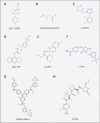Microglial NLRP3 inflammasome-mediated neuroinflammation and therapeutic strategies in depression
- PMID: 38227513
- PMCID: PMC11040318
- DOI: 10.4103/1673-5374.390964
Microglial NLRP3 inflammasome-mediated neuroinflammation and therapeutic strategies in depression
Abstract
Previous studies have demonstrated a bidirectional relationship between inflammation and depression. Activation of the nucleotide-binding oligomerization domain, leucine-rich repeat, and NLR family pyrin domain-containing 3 (NLRP3) inflammasomes is closely related to the pathogenesis of various neurological diseases. In patients with major depressive disorder, NLRP3 inflammasome levels are significantly elevated. Understanding the role that NLRP3 inflammasome-mediated neuroinflammation plays in the pathogenesis of depression may be beneficial for future therapeutic strategies. In this review, we aimed to elucidate the mechanisms that lead to the activation of the NLRP3 inflammasome in depression as well as to provide insight into therapeutic strategies that target the NLRP3 inflammasome. Moreover, we outlined various therapeutic strategies that target the NLRP3 inflammasome, including NLRP3 inflammatory pathway inhibitors, natural compounds, and other therapeutic compounds that have been shown to be effective in treating depression. Additionally, we summarized the application of NLRP3 inflammasome inhibitors in clinical trials related to depression. Currently, there is a scarcity of clinical trials dedicated to investigating the applications of NLRP3 inflammasome inhibitors in depression treatment. The modulation of NLRP3 inflammasomes in microglia holds promise for the management of depression. Further investigations are necessary to ascertain the efficacy and safety of these therapeutic approaches as potential novel antidepressant treatments.
Copyright © 2024 Copyright: © 2024 Neural Regeneration Research.
Conflict of interest statement
Figures


Similar articles
-
Targeting microglial autophagic degradation in NLRP3 inflammasome-mediated neurodegenerative diseases.Ageing Res Rev. 2021 Jan;65:101202. doi: 10.1016/j.arr.2020.101202. Epub 2020 Nov 5. Ageing Res Rev. 2021. PMID: 33161129 Review.
-
NLRP3 Inflammasome-Mediated Neuroinflammation and Related Mitochondrial Impairment in Parkinson's Disease.Neurosci Bull. 2023 May;39(5):832-844. doi: 10.1007/s12264-023-01023-y. Epub 2023 Feb 9. Neurosci Bull. 2023. PMID: 36757612 Free PMC article. Review.
-
Morinda officinalis oligosaccharides alleviate depressive-like behaviors in post-stroke rats via suppressing NLRP3 inflammasome to inhibit hippocampal inflammation.CNS Neurosci Ther. 2021 Dec;27(12):1570-1586. doi: 10.1111/cns.13732. Epub 2021 Sep 24. CNS Neurosci Ther. 2021. PMID: 34559953 Free PMC article.
-
The NLRP3 inflammasome in depression: Potential mechanisms and therapies.Pharmacol Res. 2023 Jan;187:106625. doi: 10.1016/j.phrs.2022.106625. Epub 2022 Dec 21. Pharmacol Res. 2023. PMID: 36563870 Review.
-
Targeting the microglial NLRP3 inflammasome and its role in Parkinson's disease.Mov Disord. 2020 Jan;35(1):20-33. doi: 10.1002/mds.27874. Epub 2019 Nov 4. Mov Disord. 2020. PMID: 31680318 Review.
Cited by
-
Gut-Brain Axis: Focus on Sex Differences in Neuroinflammation.Int J Mol Sci. 2024 May 15;25(10):5377. doi: 10.3390/ijms25105377. Int J Mol Sci. 2024. PMID: 38791415 Free PMC article. Review.
-
Peripheral mitochondrial DNA as a neuroinflammatory biomarker for major depressive disorder.Neural Regen Res. 2025 Jun 1;20(6):1541-1554. doi: 10.4103/NRR.NRR-D-23-01878. Epub 2024 Jun 26. Neural Regen Res. 2025. PMID: 38934398 Free PMC article.
-
Global trends of purinergic receptors and depression: A bibliometric analysis from 2003 to 2023.World J Psychiatry. 2025 Feb 19;15(2):102344. doi: 10.5498/wjp.v15.i2.102344. eCollection 2025 Feb 19. World J Psychiatry. 2025. PMID: 39974485 Free PMC article.
-
Depression and Anxiety After Radiation-Induced Brain Injury: A Review of Current Research Progress.Curr Oncol. 2025 Jul 26;32(8):419. doi: 10.3390/curroncol32080419. Curr Oncol. 2025. PMID: 40862788 Free PMC article. Review.
-
Intranasal dantrolene nanoparticles inhibit lipopolysaccharide-induced depression and anxiety behavior in mice.Res Sq [Preprint]. 2025 Apr 3:rs.3.rs-6254774. doi: 10.21203/rs.3.rs-6254774/v1. Res Sq. 2025. PMID: 40235483 Free PMC article. Preprint.
References
-
- Aghaie F, Moradifar F, Hosseini A. Rapamycin attenuates depression and anxiety-like behaviors through modulation of the NLRP3 pathway in pentylenetetrazole-kindled male Wistar rats. Fundam Clin Pharmacol. 2021;35:1045–1054. - PubMed
-
- Agius M, Bonnici H. Antidepressants in use in clinical practice. Psychiatria Danubina. 2017;29:667–671. - PubMed
-
- Alcocer-Gómez E, de Miguel M, Casas-Barquero N, Núñez-Vasco J, Sánchez-Alcazar JA, Fernández-Rodríguez A, Cordero MD. NLRP3 inflammasome is activated in mononuclear blood cells from patients with major depressive disorder. Brain Behav Immun. 2014;36:111–117. - PubMed
-
- Andina N, de Meuron L, Schnegg-Kaufmann AS, Sarangdhar MA, Ansermet C, Bombaci G, Batta K, Keller N, Porret NA, Angelillo-Scherrer A, Bonadies N, Allam R. Increased inflammasome activation is associated with aging and chronic myelomonocytic leukemia disease severity. J Immunol. 2023;210:580–589. - PubMed
LinkOut - more resources
Full Text Sources

